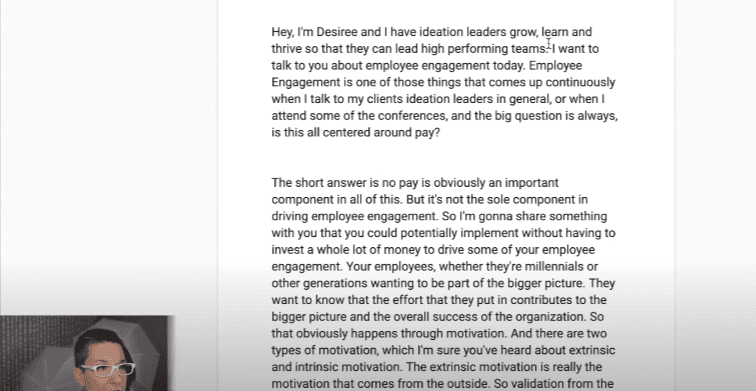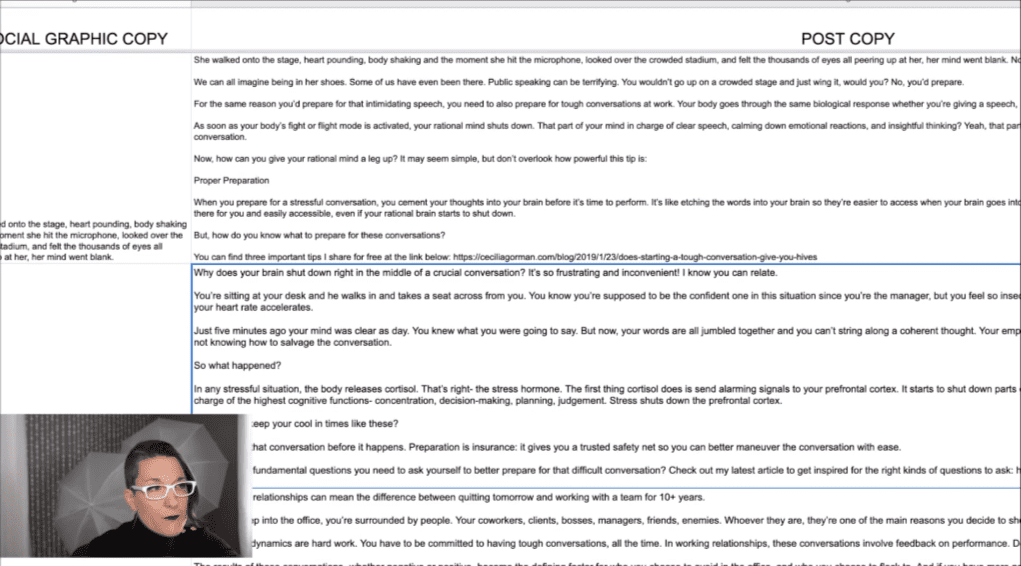Transforming Video Content into a Comprehensive Training Document
Welcome to our instructional guide on repurposing your video course content into a diverse array of text-based resources. Throughout this training, we'll outline the steps and strategies needed to maximize the educational value of your video materials by converting them into structured text documents, engaging blog posts, and dynamic social media content.
Section 1: Understanding the Process
Part 1: Video Content Assimilation
The training begins by evaluating the existing video content. Let's look at an example using one of our clients, Desiree, who is an aviation consultant. Desiree started out by shooting short videos on her iPhone, enabling her to get acquainted with video production at a manageable pace. In similar scenarios, start by collecting a few video pieces—enough to provide substantial content but not overwhelming for a novice.
Key Points:
1. Collect four or more videos to start.
2. Get comfortable producing and refining video content before investing significant resources.
Part 2: Video to Text Conversion
Next, we convert spoken words into written text. This can be done through transcription services like Otter, among others that fit your budget. This process generates a raw transcript that typically requires significant editing to make coherent as a standalone text.

- Upload the video into Otter.
- Separate the audio from the video if desired.
- Generate the transcription and create a Google Doc with the content.
Tip: Remember, the raw transcript may not make complete sense on its own and will need revision to clarify the message and structure the information.
Section 2: Crafting Written Material
Part 1: Editing for Clarity

Take the raw transcription and begin the editing process. This involves removing unnecessary filler (e.g., “I'm Desiree, and I do this, this, this”), correcting grammatical errors, and restructuring sentences to enhance readability and coherence.
Part 2: Elevating Content Quality
Once the transcript has been tidied, push it further to elevate it to blog-worthy status. At this stage, it's about refining the content to make it engaging and informative for a reading audience. The blog adapts the video material into a format suitable for your website or content-sharing platforms.
Example:
Transform this: “I'm an aviation leader client in general, or when I attend some of the aviation conferences.”
Into this: “As an aviation consultant, I encounter common concerns regarding employee engagement, both through direct client interactions and at specialized aviation conferences.”
Part 3: Generating Social Media Snippets

The next step involves extracting key points and nuggets from the blog to create social media posts. These can range from catchy one-liners to more extended commentary. Adapt the length and style of these posts to the platform and your target audience, keeping B2B posts generally longer than B2C posts.
Section 3: Content Distribution
Part 1: Social Media Integration

- Use brief, impactful lines from the blog as the text for social media graphics.
- Pair the graphics with a post that directs traffic to the video or blog post.
- For example, turn the question “Why does your brain shut down in the middle of a crucial conversation?” into a visually compelling social media post.
Part 2: Email Campaigns
Select segments of the content or certain posts to feature in email campaigns. This helps to drive your audience to various platforms to consume the full content, whether it's reading the blog, engaging with a social media post, or watching the video.
Sample Email Content:
Subject: Unlock the Secrets of Employee Engagement in Aviation
Body: Discover the surprising elements that foster a robust team dynamic within the aviation industry. Explore our latest post – and learn why employee pay isn't the whole story. Click here to dive deeper.
Part 3: Utilizing Spreadsheets and Content Management Systems

To organize and manage your content effectively, a spreadsheet or a system like Airtable can be invaluable. It helps track content status, intended platforms, and ensures that calls to action align with campaign goals, making for seamless collaboration among your team.
Conclusion
Transforming video content into varied text-based formats allows you to cater to different learning styles and preferences, maximize your content's reach, and engage your audience more profoundly. By following the outlined steps, you will proficiently turn your video resources into a treasure trove of written educational content ready for consumption across multiple platforms.
Thank you for joining this training session. We look forward to exploring further instructional elements with you soon. Goodbye for now, and see you again in our next session!

